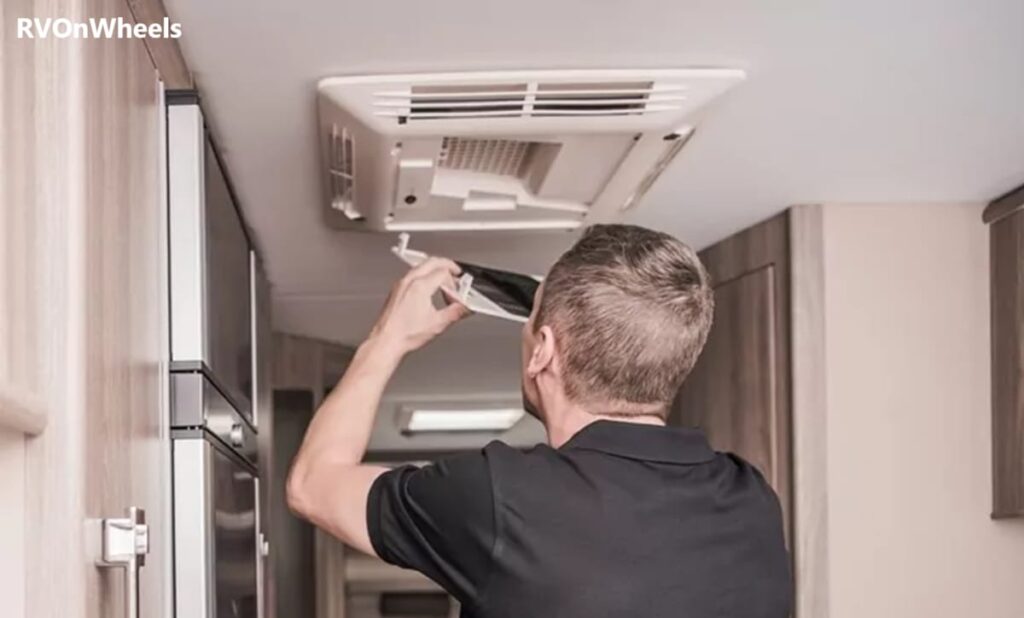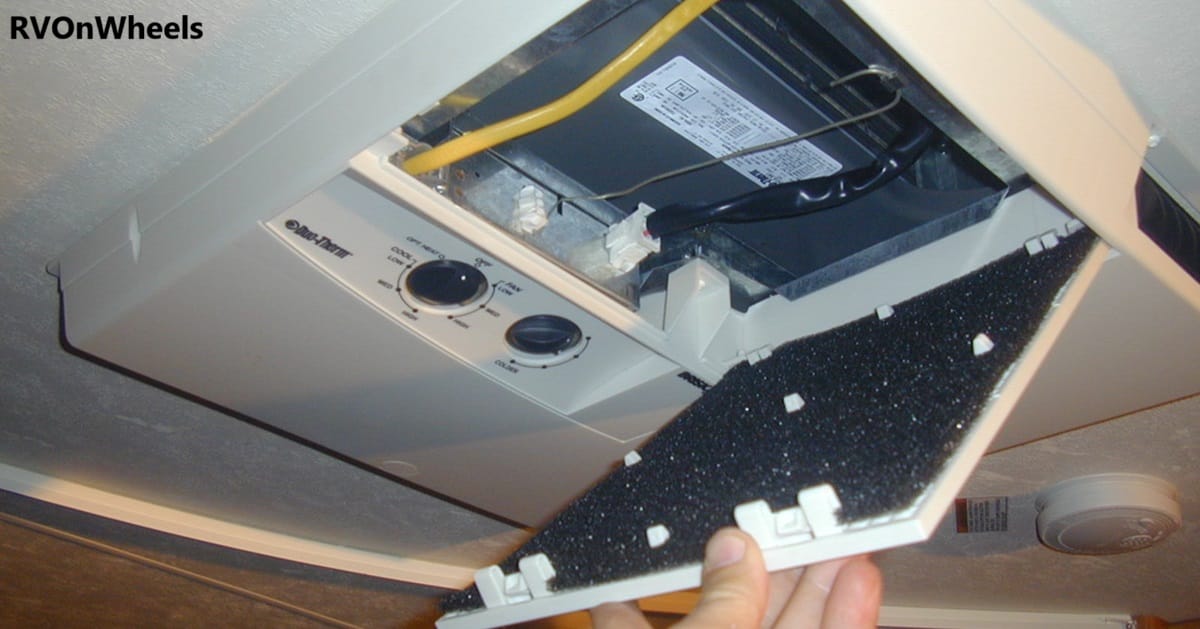Are you struggling to keep your RV cool and comfortable during your travels? If you’ve ever wondered why your air conditioning unit isn’t performing as well as it should, the inside RV AC air handler might hold the key.
The RV air handler is responsible for drawing in warm air, cooling it down through the evaporator coil, and distributing the refreshed air back into your living space. However, if the air handler isn’t functioning properly, you might experience uneven cooling, higher energy consumption, and reduced comfort.
This brief guide will tell you everything you need about inside RV AC handlers. Let’s quickly start with its main components!
What Is An Inside RV AC Air Handler?
From the name, you can have an idea, that an air handler controls the air flow inside your RV. It delivers warm or cool indoor air throughout your entire RV. An air handler is an essential component of your heat pump system. If the air handler is properly matched with your heat pump’s capacity and SEER (Seasonal Energy Efficiency Ratio), it maximizes productivity and circulates the air efficiently.
According to the Air Conditioning, Heating, and Refrigeration Institute (AHRI), mismatched systems are at least 30 percent less efficient than matched systems. The RV owners should keep this in mind before buying an AC unit. Moreover, the inside RV AC handler has a few important components that allow it to function properly. Let’s take a look at these components.
Components Of An RV AC Air Handler
The inside RV AC air handler is an essential key component of the RV’s climate control system. It distributes the cold or heated air throughout the RV. It has some essential components which allow the AC handler to work efficiently. Let’s discuss these components briefly. Here’s a breakdown of what it typically includes:
- Evaporator Coil: This component is where the actual RV cooling process happens. This coil absorbs heat when the warm air from the RV passes through it. This process cools the air, which is then blown back into the RV living space.
- Blower Motor and Fan: The function of the blower motor and fan is to power the fan. It acts like an engine. The fan pushes the cool air from the AC unit to the RV interior.
- Air Filter: The air filter is an essential component of the inside RV handler. It is present in the front of the air handler’s blower fan and evaporator coil. The filter purifies the air and traps dust, pollen, and other particles when the air moves from the handler.
- Condensate Drain Pan: The condensate drain pan cools the air and causes moisture to condense on the evaporator coil. The humidity then gathers in the drain pan. The pan then directs the water out of the RV through a drain line.
- Control Board: The control board inside the RV air handler is also a very important part of the AC unit. It receives the signals from the thermostat, such as the desired temperature, and then manages how the air handler operates. It ensures that all parts of the air handler work together smoothly.
These components ensure the smooth working of the Air handler, delivering efficient climate control throughout the RV.
How Does The Air Handler Work?
The AC handler is in a central area located under the bed or a dedicated compartment. It is a crucial part of the AC system that distributes the air through the RV. The AC air handler pulls the air through the intake vents. The air then passes over the cooling elements. The AC air handler then blows the air out through the ducts and distributes it throughout the home.
Maintenance And Care
Regular maintenance of the RV AC air handler will increase the longevity and efficiency of the AC unit. Here are some essential maintenance tips:
- Clean or Replace the Air Filter: Inspect the air filter regularly and clean it with a soft brush and warm water. Cleaning the air filter is necessary as a dirty filter restricts the airflow and reduces the cooling efficiency.
- Inspect the Blower Fan and Motor: Check the fan and motor for any signs of dust buildup or wear. Clean the fan blades and ensure the engine is running smoothly. Also, oil the motor if necessary.
- Clear the Condensate Drain: Ensure the condensate drain pan and line are clear of debris and dust to prevent water from backing up and causing potential damage.
- Check for Leaks: Look thoroughly for any water and refrigerant leaks around the air handler and fix them quickly.
- Clean the Coils: Cleaning them to ensure they can efficiently absorb and release heat. Use a soft brush or vacuum to remove dust and debris.
- Inspect Ductwork: Examine the ducts for any signs of damage or disconnections and seal any gaps to ensure efficient air distribution.
- Test the System Regularly: Run the AC to see if it works properly and find any issues early.
- Professional Servicing: It is recommended that an experienced technician inspect and service the air handler at least once a year to ensure it’s in good working condition.
Follow these maintenance tips to ensure the longevity and productivity of your RV AC. Now let’s address some common issues with the RV AC handler.
Common Issues And Troubleshooting
Even with regular maintenance, issues can arise. Here are a few common problems and their potential solutions:

Air Handler Not Turning On
Sometimes, the air handler isn’t turning on, leading to a lack of cooling in the RV. This occurs due to faults in electrical systems. To solve this issue, ensure the RV is plugged in, or the generator is running, and check the circuit breaker or fuse related to the AC system.
Making Noises
Noise may indicate that the blower fan is dirty or that there are loose or damaged fan blades. Checkout Inside RV AC air handler to find the cause. Usually you just need to clean the fan and tighten the screws to avoid banging noises. Also, check for any damage and fix it as soon as possible.
Water Leaks Or Excess Moisture
Water leaks inside RV AC handlers can cause severe damage to the AC unit. To avoid this, ensure the condensate drain pan and line are not clogged. Clean them out to allow proper water drainage. For detailed information visit Why Is My RV AC Leaking Water Inside.
Addressing these common issues helps maintain your RV’s air handler and ensures consistent performance. If you are unable to fix it yourself, you should search RV AC Repair Near Me.
Energy Efficiency Considerations
Energy efficiency considerations for the inside RV air handler involve various steps to minimize energy consumption and maximize output. Here are some key considerations:
- Keep the Air Filter Clean: A clean filter ensures enhanced airflow and system efficiency.
- Use a Programmable Thermostat: This allows you to set temperature as per your requirements and based on your needs, reducing energy consumption when cooling is not required.
- Ensure Proper Insulation: Good insulation ensures the desired temperature is maintained inside the RV, reducing the workload on the air handler.
- Regular Maintenance: Regular maintenance of the inside RV AC handlers ensures they remain in good condition, operate efficiently, and consume less energy than necessary.
Following these energy efficiency measures will enhance the performance of your RV air handler and also help in reducing operational costs.
Final Words
This was all about the inside RV AC air handler. This information is gathered after extensive research from different platforms. It controls the whole RV airflow systems. It is essential in maintaining a comfortable environment inside recreational vehicles.
They are necessary for maintaining the temperature and humidity levels, ensuring the RV remains a pleasant place to live and travel in, regardless of external weather conditions. Keep visiting RVOnWheels for the best RVing experience.
FAQs
What Is The RV AC Air Handler Price?
As of September 2024, the average cost of an RV AC air handler is between $1,500 and $3,400, including the unit and installation.
Is a Bigger Air Handler Better?
Yes, a bigger Air Handler is better because you need more volume of air to cool the RV than to heat it. So the cooling requirements determine the size of the air handler. However, the air handler comes with the furnace. So the air handler size determines the furnace size.
How Does Air Conditioning Work In An RV?
RV air conditioners operate by removing heat from the interior. The AC unit picks up the hot air from the RV interior via an intake vent and then runs the air over evaporator coils, which have refrigerants inside them. Thus, the heat in the air transfers to the refrigerants in the evaporator coils.

